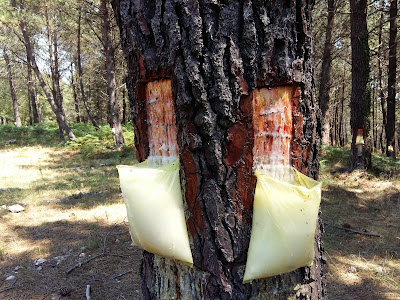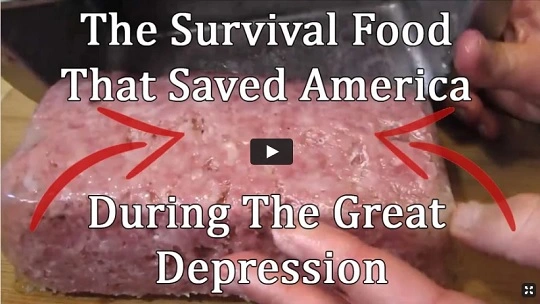Getting Back To Grandparents: 4 Survival Skills Your Great-Grandparents Knew (That Most Of Us Have Forgotten) - How to Use a Pine Tree for Survival – Food, Medicine, Fuel and Shelter
Most of the time, we think about survival in terms of having a pack filled with equipment and supplies. That’s the ideal way to do it, but you can’t always count on the ideal. There’s just as good a chance that you’ll find yourself stuck in a situation where all you have is a pocket knife and a lighter.
Survival in such a situation is much harder than with a well-filled backpack. Nevertheless, as long as it is possible, then it’s a good idea to know how to survive, using just what you can find around you.
This is where the pine tree comes in handy. While a pine tree can’t do everything for you, it can do a lot. You can use a pine tree for food, medicine, shelter and fuel, covering a lot of your needs. Learning how to use pine trees, as well as other trees and plants you find in the wilderness, could keep you alive.
1. The Pine Tree as Shelter
Pine trees make one of the easiest natural shelters you can find. The branches come out horizontally from the tree, and as the tree grows, the larger, lower branches will bend down from their weight, brushing the ground. The very bottom branches often end up dying, because they don’t get any sunlight.
If you crawl under a large pine tree, you’ll probably find a nice, soft bed of dried pine needles and a bunch of dry, dead branches. Cut those branches out of there, and you can use that space for shelter. If you don’t have enough head space, you can cut off some of the lowest live branches, and then cut the boughs off of them and put the boughs around the edges of the area covered by the branches, making walls for your shelter. A few extra branches from nearby pine trees will make this wall area even better.
In this short VIDEO, I will unearth A lost super-food will bulletproof you against any food shortage or famine. It’s a food that vanished with the Incas over 6 centuries ago
In the next crisis these lost skills will be more valuable than gold, food supplies and survival equipment combined. These skills have been tested and proven to work for centuries.
Here is just a small glimpse of what you’ll find in this massive 300-page sequel (in color)
- A lost super-food will bulletproof you against any food shortage or famine. It’s a food that vanished with the Incas over 6 centuries ago. This mysterious dish was just recently rediscovered by NASA who has been giving away rations of it to our brave men and women in their month-long space missions. The Incas stored it in pit holes for up to 10 years, ate it year-round, and actually used it to survive a 4 year long super-drought that wiped out their southern neighbors. So, if it managed to save the Incas centuries ago and it still works for our astronauts today, you can bet your last dollar it will keep you and your family well fed in any crisis. And the best part is that you probably already have the ingredients in your kitchen right now.
The tree itself will do a good job of shedding rain and snow, keeping most of it off of you. While you will get an occasional drop, it won’t be anywhere near as bad as being outdoors. If there is snow, you can pile some of the snow against the “walls” of your shelter, making it even more windproof.
It is possible to light a fire in this shelter, but you must be careful. Too large a fire will light your shelter up, with you in it. Not a good way to end your night. Be sure to dig down to bare earth, moving the needles aside, wherever you are going to build the fire. If you can, move some rocks to act as a hearth.
2. The Pine Tree for Food
I remember a commercial from years ago, where Euell Gibbons asked the question, “Have you ever eaten a pine tree?” In actuality, there are several parts of a pine tree which you can eat. While it may not supply all of your needs, it can be a big help.
To start with, you can use the needles of many pine trees for making a tea, which is high in vitamin C. Be careful, though, as the pine needles from the Norfold Island Pine and the Ponderosa Pine are poisonous. Be sure to accurately identify the pine trees in the area.
The inner bark of the pine tree is edible, as well. You want to be careful doing this, though, because if you peel the bark off all the way around, you’ll kill the tree. Better to use the inner bark from deadfalls. This inner bark can be eaten raw, boiled, fried or cooked over an open flame. Know any good pine bark recipes?
The story continues below the video
The pine nuts are also edible. You can find them in pine cones — if critters haven’t gotten to them first. To harvest them, start with fresh pine cones that haven’t had time to decompose. If you are in an area with pine trees, there will probably be plenty from which to choose. To get the pine nuts out of the cone, just tap the pine cone on a large, flat rock, rotating the pine cone as you go. The nuts should fall out.
Pine nuts that have holes in them should probably be avoided, as insects have already gotten to them. The others need to be cracked between your teeth and shelled; the nut inside is waxy, high in protein and high in fiber, as well.
Finally, the resin from the pine tree can be eaten. Make sure that it is clean and doesn’t have anything extra stuck in it.
3. Medicine from a Pine Tree
Pine trees produce resin as their own “bandage,” to cover and protect areas that are damaged, whether it is because of a critter damaging the bark or a storm breaking a branch off. You can often find this resin already on the tree, or you can peel off some bark to get it to start forming.
The resin is a natural antiseptic and disinfectant, and has antimicrobial and antifungal properties. As such, it can be applied directly to cuts, abrasions and rashes to protect them and keep germs out. In the case of bleeding, the pine resin works as a bandage to staunch blood flow and protect the wound.
Another good use for pine resin is for extracting splinters. Just dab some pine resin on the splinter, cover it and in a couple of days it will come out on its own.
Other Uses for Pine Trees
Pine resin is useful for a lot of other things, too. In olden times, they used it for waterproofing. Cover your boots or gloves with pine resin to do this. You can also put it on the seams of a tent to waterproof it.
If you need a good glue, pine resin can be used as-is. To improve it, heat it up and mix in ashes from your fire. Once cooled, the glue will harden, but like hot melted glue, will soften whenever it is heated.
If you need a fire starter in wet weather, use pine resin. Of course, the tree will provide fuel, although pine doesn’t provide as much heat per cubic foot as other, denser types of wood. Nevertheless, it is easy to start a fire made with pine wood and it will keep you warm. There are usually plenty of deadfalls or dead branches, so that you don’t need to use green wood.
Finally, you can use pine boughs for bedding, as well as for insulation. Pine boughs make one of the most comfortable mattresses you can find in the wild. If you need an extra layer of insulation to help keep you warm, cut off the tips of the branches and stuff them down inside your coat or pants. You’ll itch a lot, but you’ll be warmer, too.
I highly recommend this book: The Home Doctor – Practical Medicine for Every Household – is a 304 page doctor written and approved guide on how to manage most health situations when help is not on the way.
If you want to see what happens when things go south, all you have to do is look at Venezuela: no electricity, no running water, no law, no antibiotics, no painkillers, no anesthetics, no insulin or other important things.
But if you want to find out how you can still manage in a situation like this, you must also look to Venezuela and learn the ingenious ways they developed to cope.
This book is a unique guide for the layman that you can use when help is not on the way or to manage common ailments that don’t require seeing a doctor.
Let me show you just some of the things you’ll find inside the Home Doctor:
Do you know of other survival uses for pine trees? Share them in the section below:





Comments
Post a Comment